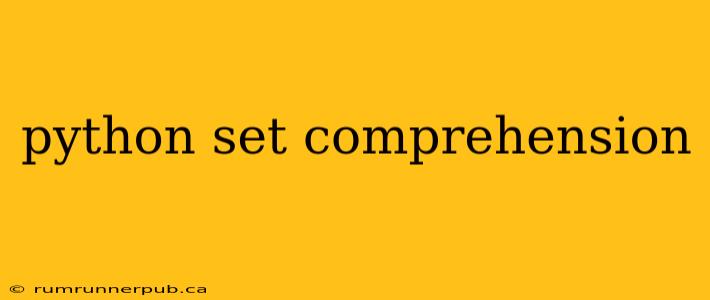Set comprehension in Python offers a powerful and elegant way to create sets. It's a more compact and often faster alternative to using the set() constructor with a list comprehension or a traditional for loop. This article will explore set comprehensions, drawing upon insights from Stack Overflow to enhance understanding and provide practical examples.
What is Set Comprehension?
Set comprehension provides a concise syntax for creating sets in Python. It follows the general structure:
{expression for item in iterable if condition}
expression: This is the value that will be added to the resulting set for each item. It can be a simple variable or a more complex calculation.item: A variable representing each element in the iterable.iterable: A sequence (like a list, tuple, or string) or other iterable object that you'll iterate over.if condition: (Optional) A conditional statement that filters the elements from the iterable before they're added to the set. Only items satisfying the condition will be included.
Examples Inspired by Stack Overflow
Let's illustrate with examples, drawing inspiration from common questions on Stack Overflow:
Example 1: Squaring Even Numbers (Inspired by similar questions on SO)
Let's say we want to create a set containing the squares of even numbers from a list. A traditional approach might look like this:
numbers = [1, 2, 3, 4, 5, 6]
even_squares = set()
for number in numbers:
if number % 2 == 0:
even_squares.add(number**2)
print(even_squares) # Output: {4, 16, 36}
Using set comprehension, this becomes significantly more concise:
numbers = [1, 2, 3, 4, 5, 6]
even_squares = {number**2 for number in numbers if number % 2 == 0}
print(even_squares) # Output: {4, 16, 36}
Example 2: Removing Duplicates and Converting to Uppercase (Inspired by SO questions on string manipulation)
Suppose we have a list of strings, and we want to create a set containing the unique uppercase versions of those strings. A set comprehension elegantly handles both duplicate removal and transformation:
strings = ["apple", "banana", "Apple", "orange", "Banana"]
unique_uppercase = {s.upper() for s in strings}
print(unique_uppercase) # Output: {'BANANA', 'ORANGE', 'APPLE'}
Example 3: Nested Iteration (Addressing complexities found in SO)
Set comprehension can handle nested iterations, though the readability can decrease with excessive nesting. Let's create a set of all possible pairs from two lists:
list1 = [1, 2]
list2 = ['a', 'b']
pairs = {(x, y) for x in list1 for y in list2}
print(pairs) # Output: {(1, 'a'), (1, 'b'), (2, 'a'), (2, 'b')}
Advantages of Set Comprehension
- Readability: For simple set creations, set comprehensions are often more readable and easier to understand than multi-line alternatives.
- Efficiency: Set comprehensions can be more efficient than using loops and the
add()method, especially for large datasets. This is because the underlying implementation is optimized for set creation. - Conciseness: They drastically reduce the amount of code needed, making your programs cleaner and easier to maintain.
When to Avoid Set Comprehension
While powerful, set comprehension isn't always the best choice. For very complex logic or deeply nested iterations, it can become difficult to read and debug. In such cases, a more explicit approach with loops might be preferred for maintainability. Additionally, if the logic for generating set members is exceptionally convoluted, breaking it down into smaller, more manageable functions may improve overall code clarity.
Conclusion
Python set comprehension offers a significant advantage in writing concise and efficient code for creating sets. By understanding its syntax and leveraging its capabilities, you can greatly enhance the elegance and readability of your Python programs. Remember to consider readability and maintainability when choosing between set comprehension and more traditional methods, particularly when dealing with complex operations. Remember to always give credit where credit is due; while this article synthesizes information, the core concepts are derived from the collective wisdom of the Stack Overflow community.
